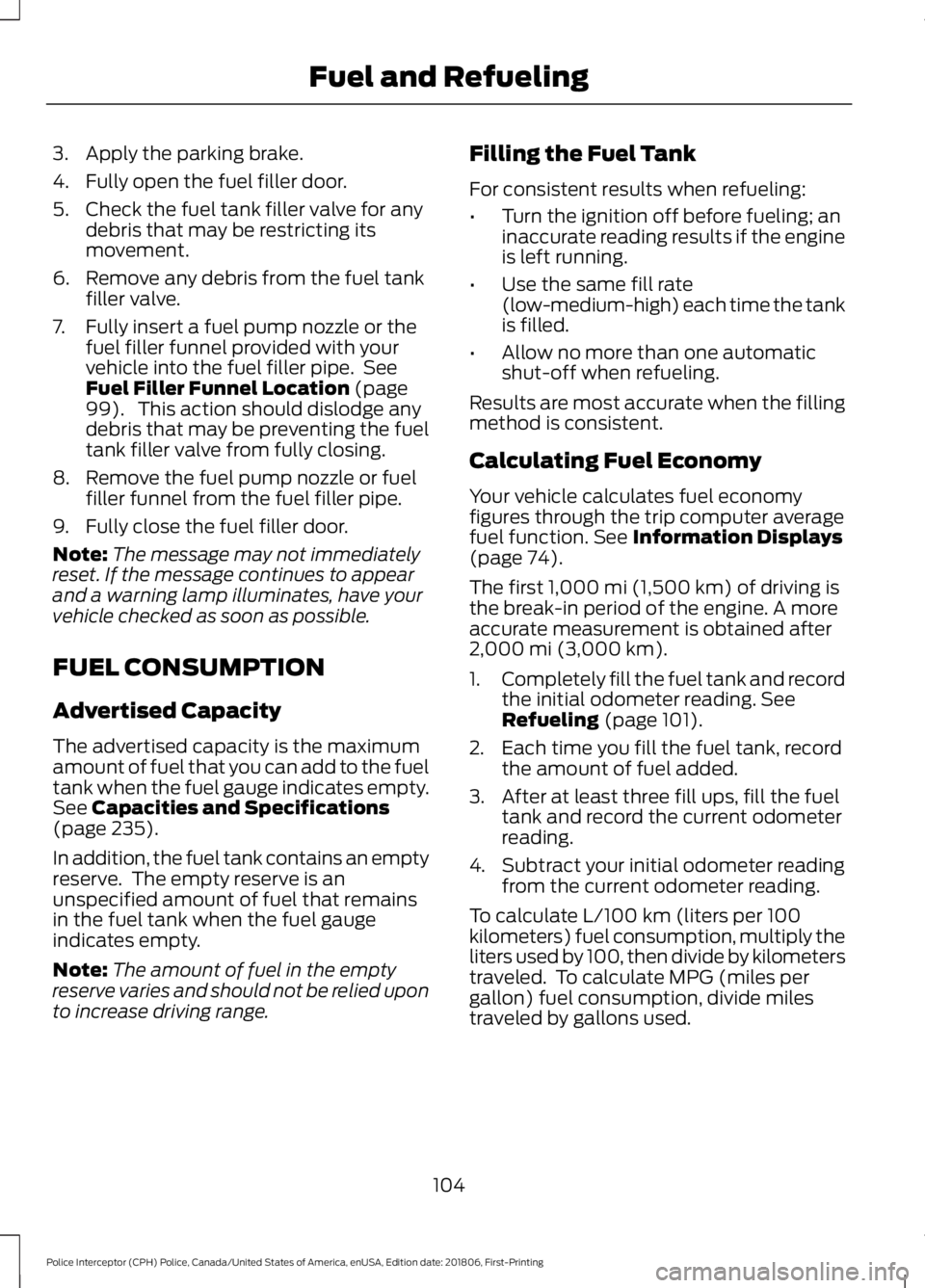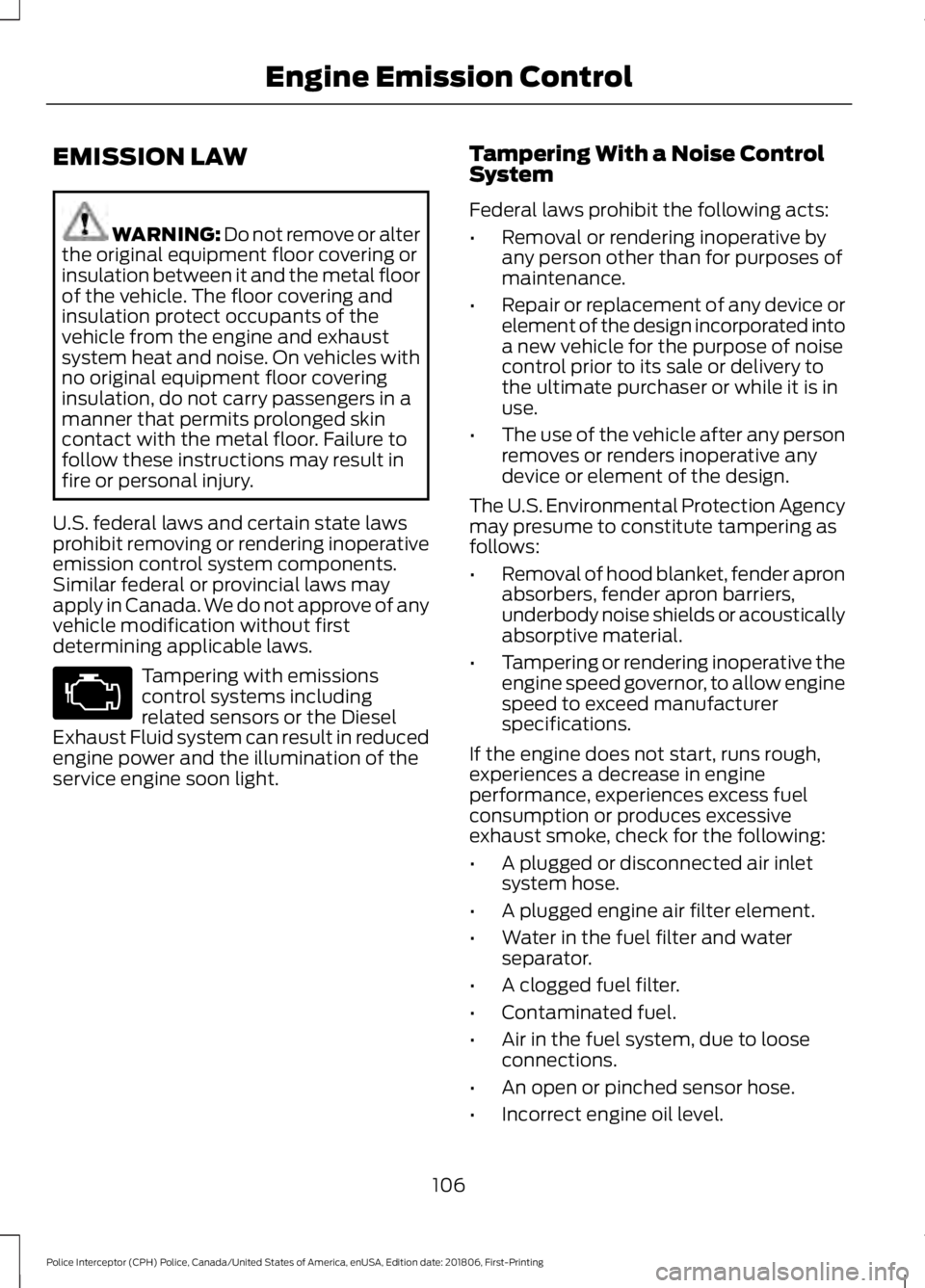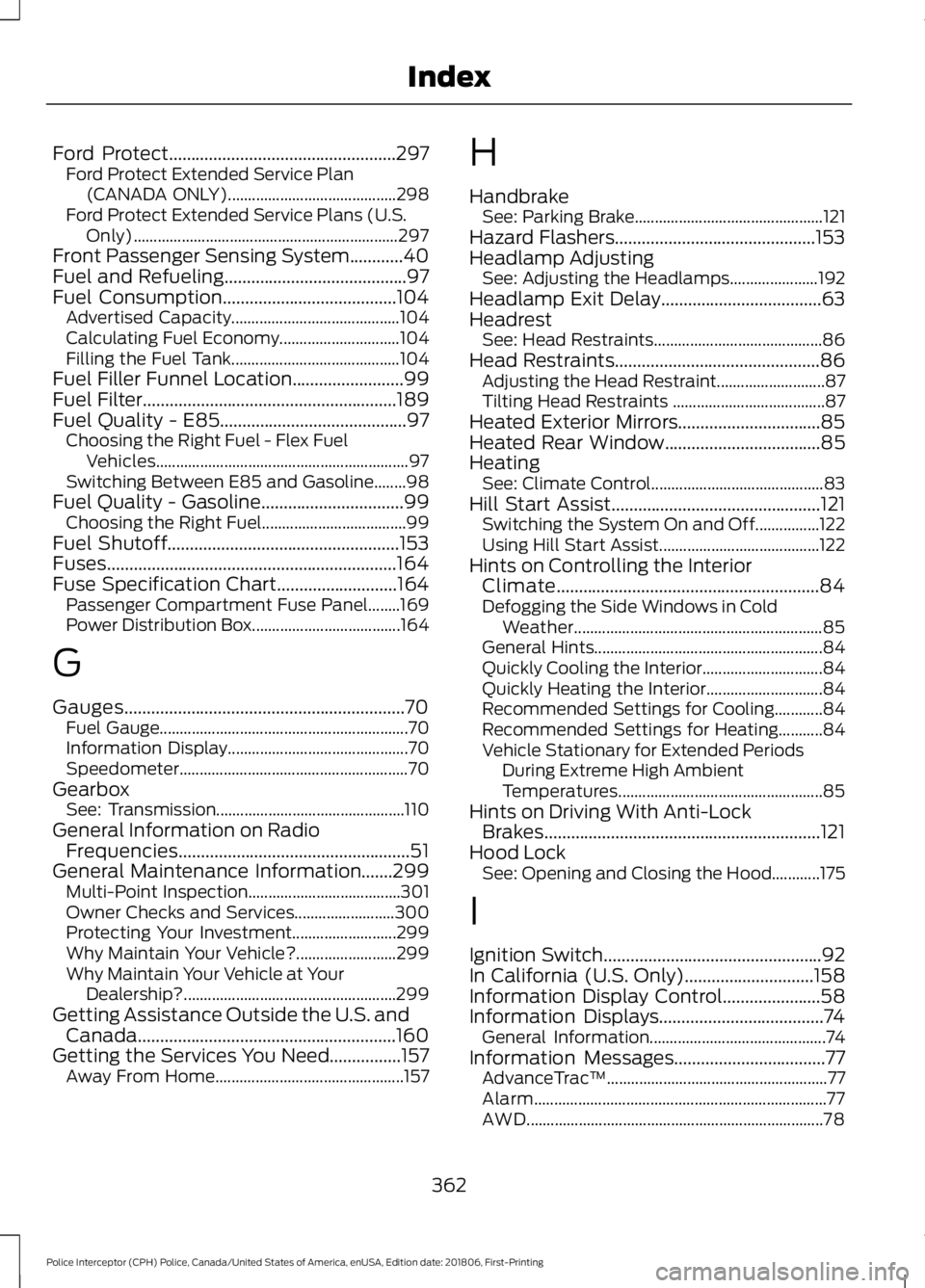2019 FORD POLICE INTERCEPTOR fuel consumption
[x] Cancel search: fuel consumptionPage 5 of 370

Lighting
General Information
......................................61
Lighting Control ..............................................
61
Autolamps .......................................................
62
Instrument Lighting Dimmer ....................
63
Headlamp Exit Delay ...................................
63
Daytime Running Lamps ...........................
64
Direction Indicators ......................................
64
Interior Lamps ................................................
64
Windows and Mirrors
Power Windows ............................................
66
Exterior Mirrors ...............................................
67
Interior Mirror ..................................................
68
Sun Visors ........................................................
69
Instrument Cluster
Gauges ..............................................................
70
Warning Lamps and Indicators .................
71
Audible Warnings and Indicators .............
73
Information Displays
General Information .....................................
74
Information Messages .................................
77
Climate Control
Manual Climate Control .............................
83
Hints on Controlling the Interior Climate ........................................................................\
..
84
Heated Rear Window ..................................
85
Heated Exterior Mirrors ...............................
85
Cabin Air Filter ................................................
85
Seats
Sitting in the Correct Position ..................
86
Head Restraints .............................................
86
Manual Seats .................................................
88
Power Seats ....................................................
89Auxiliary Power Points
Auxiliary Power Points
................................
90
Storage Compartments
Center Console ...............................................
91
Overhead Console .........................................
91
Starting and Stopping the Engine
General Information .....................................
92
Ignition Switch ................................................
92
Starting a Gasoline Engine ........................
93
Engine Block Heater ....................................
94
Police Engine Idle Feature .........................
95
Fuel and Refueling
Safety Precautions .......................................
97
Fuel Quality - E85 .........................................
97
Fuel Quality - Gasoline ...............................
99
Fuel Filler Funnel Location ........................
99
Running Out of Fuel .....................................
99
Refueling ..........................................................
101
Fuel Consumption ......................................
104
Engine Emission Control
Emission Law ................................................
106
Catalytic Converter .....................................
107
Transmission
Automatic Transmission ...........................
110
All-Wheel Drive
Using All-Wheel Drive .................................
113
Brakes
General Information ...................................
120
Hints on Driving With Anti-Lock Brakes ........................................................................\
..
121
Parking Brake ..................................................
121
2
Police Interceptor (CPH) Police, Canada/United States of America, enUSA, Edition date: 201806, First-Printing Table of Contents
Page 107 of 370

3. Apply the parking brake.
4. Fully open the fuel filler door.
5. Check the fuel tank filler valve for any
debris that may be restricting its
movement.
6. Remove any debris from the fuel tank filler valve.
7. Fully insert a fuel pump nozzle or the fuel filler funnel provided with your
vehicle into the fuel filler pipe. See
Fuel Filler Funnel Location (page
99). This action should dislodge any
debris that may be preventing the fuel
tank filler valve from fully closing.
8. Remove the fuel pump nozzle or fuel filler funnel from the fuel filler pipe.
9. Fully close the fuel filler door.
Note: The message may not immediately
reset. If the message continues to appear
and a warning lamp illuminates, have your
vehicle checked as soon as possible.
FUEL CONSUMPTION
Advertised Capacity
The advertised capacity is the maximum
amount of fuel that you can add to the fuel
tank when the fuel gauge indicates empty.
See
Capacities and Specifications
(page 235).
In addition, the fuel tank contains an empty
reserve. The empty reserve is an
unspecified amount of fuel that remains
in the fuel tank when the fuel gauge
indicates empty.
Note: The amount of fuel in the empty
reserve varies and should not be relied upon
to increase driving range. Filling the Fuel Tank
For consistent results when refueling:
•
Turn the ignition off before fueling; an
inaccurate reading results if the engine
is left running.
• Use the same fill rate
(low-medium-high) each time the tank
is filled.
• Allow no more than one automatic
shut-off when refueling.
Results are most accurate when the filling
method is consistent.
Calculating Fuel Economy
Your vehicle calculates fuel economy
figures through the trip computer average
fuel function.
See Information Displays
(page 74).
The first
1,000 mi (1,500 km) of driving is
the break-in period of the engine. A more
accurate measurement is obtained after
2,000 mi (3,000 km)
.
1. Completely fill the fuel tank and record
the initial odometer reading.
See
Refueling (page 101).
2. Each time you fill the fuel tank, record the amount of fuel added.
3. After at least three fill ups, fill the fuel tank and record the current odometer
reading.
4. Subtract your initial odometer reading from the current odometer reading.
To calculate L/100 km (liters per 100
kilometers) fuel consumption, multiply the
liters used by 100, then divide by kilometers
traveled. To calculate MPG (miles per
gallon) fuel consumption, divide miles
traveled by gallons used.
104
Police Interceptor (CPH) Police, Canada/United States of America, enUSA, Edition date: 201806, First-Printing Fuel and Refueling
Page 109 of 370

EMISSION LAW
WARNING: Do not remove or alter
the original equipment floor covering or
insulation between it and the metal floor
of the vehicle. The floor covering and
insulation protect occupants of the
vehicle from the engine and exhaust
system heat and noise. On vehicles with
no original equipment floor covering
insulation, do not carry passengers in a
manner that permits prolonged skin
contact with the metal floor. Failure to
follow these instructions may result in
fire or personal injury.
U.S. federal laws and certain state laws
prohibit removing or rendering inoperative
emission control system components.
Similar federal or provincial laws may
apply in Canada. We do not approve of any
vehicle modification without first
determining applicable laws. Tampering with emissions
control systems including
related sensors or the Diesel
Exhaust Fluid system can result in reduced
engine power and the illumination of the
service engine soon light. Tampering With a Noise Control
System
Federal laws prohibit the following acts:
•
Removal or rendering inoperative by
any person other than for purposes of
maintenance.
• Repair or replacement of any device or
element of the design incorporated into
a new vehicle for the purpose of noise
control prior to its sale or delivery to
the ultimate purchaser or while it is in
use.
• The use of the vehicle after any person
removes or renders inoperative any
device or element of the design.
The U.S. Environmental Protection Agency
may presume to constitute tampering as
follows:
• Removal of hood blanket, fender apron
absorbers, fender apron barriers,
underbody noise shields or acoustically
absorptive material.
• Tampering or rendering inoperative the
engine speed governor, to allow engine
speed to exceed manufacturer
specifications.
If the engine does not start, runs rough,
experiences a decrease in engine
performance, experiences excess fuel
consumption or produces excessive
exhaust smoke, check for the following:
• A plugged or disconnected air inlet
system hose.
• A plugged engine air filter element.
• Water in the fuel filter and water
separator.
• A clogged fuel filter.
• Contaminated fuel.
• Air in the fuel system, due to loose
connections.
• An open or pinched sensor hose.
• Incorrect engine oil level.
106
Police Interceptor (CPH) Police, Canada/United States of America, enUSA, Edition date: 201806, First-Printing Engine Emission Control
Page 365 of 370

Ford Protect...................................................297
Ford Protect Extended Service Plan
(CANADA ONLY).......................................... 298
Ford Protect Extended Service Plans (U.S. Only).................................................................. 297
Front Passenger Sensing System............40
Fuel and Refueling.........................................97
Fuel Consumption
.......................................104
Advertised Capacity.......................................... 104
Calculating Fuel Economy.............................. 104
Filling the Fuel Tank.......................................... 104
Fuel Filler Funnel Location.........................99
Fuel Filter
.........................................................189
Fuel Quality - E85..........................................97 Choosing the Right Fuel - Flex Fuel
Vehicles............................................................... 97
Switching Between E85 and Gasoline........98
Fuel Quality - Gasoline................................99 Choosing the Right Fuel.................................... 99
Fuel Shutoff
....................................................153
Fuses.................................................................164
Fuse Specification Chart
...........................164
Passenger Compartment Fuse Panel........169
Power Distribution Box..................................... 164
G
Gauges...............................................................70 Fuel Gauge.............................................................. 70
Information Display............................................. 70
Speedometer......................................................... 70
Gearbox See: Transmission............................................... 110
General Information on Radio Frequencies....................................................51
General Maintenance Information.......299 Multi-Point Inspection...................................... 301
Owner Checks and Services......................... 300
Protecting Your Investment.......................... 299
Why Maintain Your Vehicle?......................... 299
Why Maintain Your Vehicle at Your Dealership?..................................................... 299
Getting Assistance Outside the U.S. and Canada..........................................................160
Getting the Services You Need................157 Away From Home............................................... 157H
Handbrake
See: Parking Brake............................................... 121
Hazard Flashers.............................................153
Headlamp Adjusting See: Adjusting the Headlamps...................... 192
Headlamp Exit Delay....................................63
Headrest See: Head Restraints.......................................... 86
Head Restraints
..............................................86
Adjusting the Head Restraint........................... 87
Tilting Head Restraints ...................................... 87
Heated Exterior Mirrors................................85
Heated Rear Window...................................85
Heating See: Climate Control........................................... 83
Hill Start Assist...............................................121 Switching the System On and Off................122
Using Hill Start Assist........................................ 122
Hints on Controlling the Interior Climate...........................................................84
Defogging the Side Windows in Cold Weather.............................................................. 85
General Hints......................................................... 84
Quickly Cooling the Interior.............................. 84
Quickly Heating the Interior............................. 84
Recommended Settings for Cooling............84
Recommended Settings for Heating...........84
Vehicle Stationary for Extended Periods During Extreme High Ambient
Temperatures................................................... 85
Hints on Driving With Anti-Lock Brakes..............................................................121
Hood Lock See: Opening and Closing the Hood............175
I
Ignition Switch.................................................92
In California (U.S. Only).............................158
Information Display Control......................58
Information Displays.....................................74 General Information............................................ 74
Information Messages
..................................77
AdvanceTrac ™....................................................... 77
Alarm........................................................................\
. 77
AWD........................................................................\
.. 78
362
Police Interceptor (CPH) Police, Canada/United States of America, enUSA, Edition date: 201806, First-Printing Index